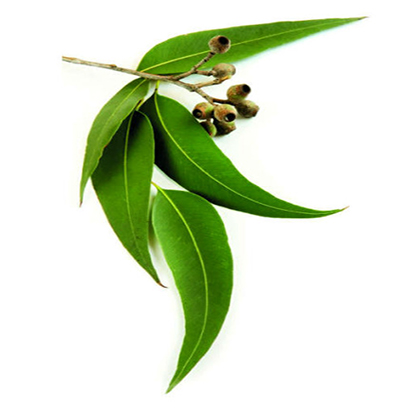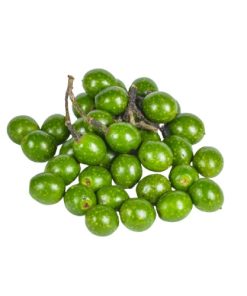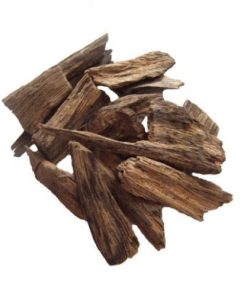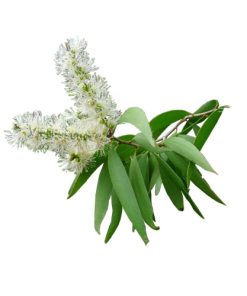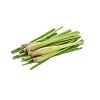Plant Description
Corymbia citriodora, commonly called lemon-scented gum is native to Australia. It is a tall, slender, broadleaf evergreen tree that will grow 60-100’ tall in its native habitat. Features smooth gray bark and narrow lance-shaped yellowish-green leaves (to 7” long) that are lemon-scented. Small white flowers in 3-flowered umbels. Flowers rarely appear on young trees or container plants. In the St. Louis area, it may be grown as an annual from seed, typically growing rapidly to 6-8’ tall in one growing season. Synonymous with Eucalyptus citriodora.
The oil is extracted via steam distillation of the leaves and green branchlets. Lemon Eucalyptus is grown in plantations.
Lemon Eucalyptus Oil Properties:
Appearance: Only Liquid
Color: Pale yellow to amber yellow color
Odour: Lemon fresh scent
Relative Density: @ 20°C: 0.865-0.880
Refractive Index @ 20°C:1.450-1.460
Optical Rotation: -1° to +7°
Main components:
Citronellal: 70-90%, citronellol: 4-12%, isopulegol: 1.5-18%
Lemon Eucalyptus Oil Uses:
Traditional Usage; The bark produced gum exudates (kino), it was believed to be antibiotic and was used as an astringent for treating diarrhoea.
Early European Usage; Early settlers also used the gum exudates for treating diarrhoea and used the leaves in sachets to keep silverfish and cockroaches out of clothing storage. It has a hard durable timber and was used for bridge construction, tool handles, framing, flooring and case manufacture
Present Day Usage; Eucalyptus Lemon Scented Gum essential oil is being used aromatherapy, in the perfume industry to manufacture other aromas, the citronellal is primarily used for this. The trees flowers produce a nice honey for beekeepers. The tree is popular as an attractive park or garden tree.
Precautions:
Cassia oil should not be used on the skin as it is a dermal irritant, dermal sensitizer and is a mucus membrane irritant. It must also be avoided in pregnancy.
Specifications

SPECIFICATIONS
| Product name |
LEMONGRASS OIL |
Botanical Source |
Corymbia citriodora |
| Origin |
Australia |
Batch No. |
LEEUCA0524 |
| Part use |
Leaf |
Method |
Steam distillation |
| Manufacturing date |
05/2024 |
Best before |
05/2027 |
| Cas No. |
85203-56-1 |
FEMA No |
2225 |
| No |
Parameter |
Specifications |
| 01 |
Appearance |
Pale yellow to amber yellow color, odour of Lemon fresh scent |
| 02 |
Identification |
Lemon Eucalyptus Oil |
| 03 |
Solubility |
Soluble in alcohol and other Organic solvents & Insoluble in water |
| 04 |
Specific Gravity at 20ºC |
0.865 – 0.880 |
| 05 |
Refractive Index at 20ºC |
1.450 – 1.460 |
| 06 |
Optical Rotation at 20ºC |
-1° to +7° |
| 07 |
Main Constituents |
70-90%, citronellol: 4-12%, isopulegol: 1.5-18% |
Shelf life: 36 months from date of manufacture.
Storage: Store in airtight containers in cool & dry place away from light & heat.
Caution: Possible skin sensitivity. Keep out of reach of children. If you are pregnant, nursing, or under a doctor’s care, consult your physician. Avoid contact with eyes, inner ears, and sensitive areas.
MSDS

MATERIAL SAFETY DATA SHEET
(according to Regulation (EU) No. 1907/2006)
Product name: Organic Cassia Oil
Number: QUE1223
1. IDENTIFICATION OF SUBSTANCE/PREPARATION & COMPANY.
Product name: Lemon Eucalyptus Oil
Manufacturer/Supplier: Australia Natural Products
Add: SE 51, 2 Mayfair Street, West Perth, WA 6005, Australia
Emergency telephone: +61 452101623
Email: [email protected]
2. COMPOSITION / INFORMATION ON INGREDIENTS.
Definition/Botanical Origin: The Lemon Eucalyptus Oil obtained by steam distillation from freshly leaves of Corymbia citriodora (formerly Eucalyptus citriodora) tree original from Australia.
Composition: 100% pure & natural
CAS No: 85203-56-1
FEMA: 2225
INCI Name: Corymbia citriodora (formerly Eucalyptus citriodora) leaves oil
3. HAZARDS IDENTIFICATION.
This product is not hazardous. Not dangerous for the environment.
H304 May be fatal if swallowed and enters airways
H315 Causes skin irritation
H317 May cause an allergic skin reaction
H319 Causes serious eye irritation
4. FIRST-AID MEASURES.
Inhalation: Remove from exposure site to fresh air. Keep at rest. Obtain medical attention.
Eye contact: Rinse immediately with plenty of water for at least 15 mins. Contact a doctor if symptoms persist.
Skin contact: Remove contaminated clothes. Wash thoroughly with soap & water, flush with plenty of water. If irritation persists, seek medical advice.
Ingestion: Rinse mouth out with water. Seek medical advice immediately.
Other: When assessing action take Risk & Safety Phrases into account (Section 15)
5. FIRE FIGHTING MEASURES.
Extinguishing media Use CO2, Dry Powder or Foam type Extinguishers, spraying extinguishing media to base of flames. Do not use direct water jet on burning material.
Special measures: Avoid vapour inhalation. Keep away from sources of ignition. Do not smoke. Wear positive pressure self-contained breathing apparatus & protective clothing.
Extinguishing procedures: Closed containers may build up pressure when exposed to heat and should be cooled with water spray.
6. ACCIDENTAL RELEASE MEASURES.
Personal precautions: Avoid inhalation & direct contact with skin & eyes. Use individual protective equipment (safety glasses, waterproof-boots, suitable protective clothing) in case of major spillages.
Environment precautions: Keep away from drains, soils, surface & groundwaters.
Cleaning up methods Remove all potential ignition sources. Contain spilled material. Cover for spillages: with an inert or non-combustible inorganic absorbent material, sweep up and remove to an approved disposal container. Observe state, federal & local disposal regulations.
7. HANDLING & STORAGE.
Precautions in handling: Apply good manufacturing practice & industrial hygiene practices, ensuring proper ventilation. Observe good personal hygiene, and do not eat, drink or smoke whilst handling.
Storage conditions: Store in tightly closed original container, in a cool, dry & ventilated area away from heat sources & protected from light. Keep air contact to a minimum.
Fire protection: Keep away from ignition sources & naked flames. Take precautions to avoid static discharges in working area.
8. EXPOSURE CONTROLS/PERSONAL PROTECTION.
Respiratory protection: Avoid breathing product vapour. Apply local ventilation where possible.
Ventilation: Ensure good ventilation of working area.
Hand protection: Avoid all skin contact. Use chemically resistant gloves if required.
Eye protection: Use safety glasses.
Work/Hygiene practices: Wash hands with soap & water after handling.
9. PHYSICAL & CHEMICAL PROPERTIES.
Appearance: Only Liquid
Color: Pale yellow to amber yellow color
Odour: Lemon fresh scent
Relative Density: @ 20°C: 0.865 – 0.880
Refractive Index @ 20°C:1.450 – 1.460
Optical Rotation: -1° to +7°
Main components:
Citronellal: 70-90%, citronellol: 4-12%, isopulegol: 1.5-18%
Flash point: 100°C
Solubility in water vegetable oils: Insoluble
Solubility in alcohol: Soluble
10. STABILITY & REACTIVITY.
Reactivity: It presents no significant reactivity hazards, by itself or in contact with water. Avoid contact with strong acids, alkali or oxidising agents.
Decomposition: Liable to cause smoke & acrid fumes during combustion: carbon monoxide, carbon dioxide & other non-identified organic compounds may be formed.
11. TOXICOLOGICAL INFORMATION.
According to current information, not classed as hazardous to health in normal industrial use.
12. ECOLOGICAL INFORMATION.
Biodegradability: Data not available
Precautions: Prevent surface contamination of soil, ground & surface water.
13. DISPOSAL CONSIDERATIONS.
Avoid disposing to drainage systems and into the environment. Seek expert advice.
14. TRANSPORT REGULATIONS.
Shipping by Road (ADR/RID): This product is not considered as dangerous goods
Shipping by Air (IATA) : This product is not considered as dangerous goods
Shipping by Sea (IMDG): This product is not considered as dangerous goods
Precaution: When shipping as non-bulk, this product can be shipped as Non Regulated.
Packing: Safety packing in HDPE or Aluminum drum
Label: Lemon Eucalyptus Oil
15. REGULATORY INFORMATION. According to Directive 88/379/EEC
Hazards: Harmful
Symbols: n/a
Risk Phrases: Harmful if swallowed
Safety Phrases: If swallowed seek medical advice immediately and show the container / label.
16. OTHER INFORMATION.
Cosmetics Directive – 7th Amendment – Not Restricted
Check maximum usage levels for skin care products.
PACKAGING:
| Type |
Suitability |
| Glass |
Yes |
| Lacquer lined steel/tin |
Yes |
| Aluminium |
Yes |
| HDPE |
Yes |
SHELF LIFE.
Best before 36 months from manufacturing date.
Q.C. REQUIREMENTS.
In-line with general product specification. Always satisfy suitability for specific application.
The data provided in this material safety data sheet is meant to represent typical data/analysis for this product and is correct to the best of our knowledge. The data was obtained from current and reliable sources, but is supplied without warranty, expressed or implied, regarding its’ correctness or accuracy. It is the user’s responsibility to determine safe conditions for the use of this product, and to assume liability for loss, injury, damage or expense arising from improper use of this product. The information provided does not constitute a contract to supply to any specification, or for any given application, and buyers should seek to verify their requirements and product use.
GC/MS

GC/MS TEST REPORT (Gas Chromatography-Mass Spectroscopy)
| Product name |
ORGANIC LEMON EUCALYPTUS OIL |
Botanical Source |
Corymbia citriodora |
| Manufacturer date |
05/2024 |
Best before |
05/2027 |
| Original |
Australia |
Batch No. |
LEEUCA0524 |
| Cas No. |
85203-56-1 |
FEMA No |
2225 |
| Number |
RT |
Area % |
Compound Name |
Chemical Family |
| 1 |
6.26 |
0.03% |
(E)-Hex-3-en-1-ol |
Aliphatic Alcohol |
| 2 |
7.90 |
0.07% |
Isobutyl isobutyrate |
Aliphatic Ester |
| 3 |
8.31 |
0.03% |
alpha-Thujene |
Monoterpene |
| 4 |
8.57 |
0.28% |
alpha-Pinene |
Monoterpene |
| 5 |
10.16 |
0.07% |
Sabinene |
Monoterpene |
| 6 |
10.33 |
1.01% |
beta-Pinene |
Monoterpene |
| 7 |
10.91 |
0.12% |
Myrcene |
Monoterpene |
| 8 |
11.57 |
0.01% |
alpha-Phellandrene |
Monoterpene |
| 9 |
11.92 |
0.03% |
Isoamyl isobutyrate |
Aliphatic Ester |
| 10 |
12.05 |
0.04% |
2-Methylbutyl isobutyrate |
Aliphatic Ester |
| 11 |
12.38 |
0.04% |
para-Cymene |
Monoterpene |
| 12 |
12.59 |
0.17% |
Limonene |
Monoterpene |
| 13 |
12.69 |
0.72% |
1,8-Cineole |
Monoterpene Ether |
| 14 |
12.97 |
0.15% |
(Z)-beta-Ocimene |
Monoterpene |
| 15 |
13.43 |
0.03% |
(E)-beta-Ocimene |
Monoterpene |
| 16 |
13.70 |
0.09% |
Bergamal |
Aliphatic Aldehyde |
| 17 |
13.92 |
0.21% |
gamma-Terpinene |
Monoterpene |
| 18 |
14.50 |
0.14% |
p-Mentha-3,8-diene |
Monoterpene |
| 19 |
15.16 |
0.25% |
Terpinolene |
Monoterpene |
| 20 |
15.88 |
0.30% |
Linalool |
Monoterpenol |
| 21 |
16.32 |
0.03% |
cis-Rose oxide |
Monoterpene Ether |
| 22 |
17.19 |
0.03% |
Alloocimene |
Monoterpene |
| 23 |
17.27 |
0.04% |
alpha-Thujone |
Monoterpene Ketone |
| 24 |
18.07 |
7.92% |
Isopulegol |
Monoterpenol |
| 25 |
18.50 |
71.77% |
Citronellal |
Monoterpene Aldehyde |
| 26 |
18.86 |
0.01% |
Menthone |
Monoterpene Ketone |
| 27 |
19.04 |
0.55% |
Isoisopulegol |
Monoterpenol |
| 28 |
19.54 |
0.05% |
Terpinen-4-ol |
Monoterpenol |
| 29 |
20.21 |
0.09% |
alpha-Terpineol |
Monoterpenol |
| 30 |
21.61 |
0.06% |
Nerol |
Monoterpenol |
| 31 |
21.81 |
7.69% |
Citronellol |
Monoterpenol |
| 32 |
22.21 |
0.02% |
Neral |
Monoterpene Aldehyde |
| 33 |
22.81 |
0.13% |
Geraniol |
Monoterpenol |
| 34 |
23.16 |
0.01% |
Methyl citronellate |
Monoterpene Ester |
| 35 |
23.55 |
0.04% |
Citral |
Monoterpene Aldehyde |
| 36 |
25.346 |
0.04% |
4-Vinylguaiacol |
Monoterpene Aldehyde |
| 37 |
26.37 |
0.03% |
delta-Elemene |
Sesquiterpene |
| 38 |
27.21 |
0.80% |
Citronellyl acetate |
Monoterpene Ester |
| 39 |
28.44 |
0.01% |
Geranyl acetate |
Monoterpene Ester |
| 40 |
28.84 |
0.03% |
beta-Elemene |
Sesquiterpene |
| 41 |
28.92 |
0.10% |
cis-Jasmone |
Jasmonate |
| 42 |
30.04 |
1.39% |
cis-Caryophyllene |
Sesquiterpene |
| 43 |
30.51 |
0.01% |
gamma-Elemene |
Sesquiterpene |
| 44 |
31.50 |
0.08% |
alpha-Humulene |
Sesquiterpene |
| 45 |
31.69 |
0.01% |
allo-Aromadendrene |
Sesquiterpene |
| 46 |
32.56 |
0.05% |
gamma-Muurolene |
Sesquiterpene |
| 47 |
33.00 |
0.01% |
gamma-Gurjunene |
Sesquiterpene |
| 48 |
33.16 |
0.07% |
Bicyclogermacrene |
Sesquiterpene |
| 49 |
34.12 |
0.02% |
beta-Cadinene |
Sesquiterpene |
| 50 |
36.31 |
0.02% |
Spathulenol |
Sesquiterpenol |
| 51 |
36.48 |
0.07% |
Caryophyllene oxide |
Sesquiterpene Ether |
| Total Percentage |
94.97% |


